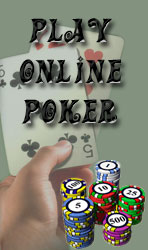Pokerwiner.com → Lessons of poker
However, if the two pair plays incorrectly and call after you raise, you do best of all, because when an opponent make a mistake, you gain.
What your raise did was to reduce correct odds for a call into incorrect odds for a call.
The curious effect of this turn about is that although you raised to drive the two pair out, you are rooting for him to call after you raise.
To prove this point, let’s see what happens over ten average hands if:
1. You call, and the two pair calls behind you.
2. You raise, and the two pair folds.
3. You raise, and the two pair calls your raise.
If you call and the two pair calls, you will win nine out of ten hands.
Assuming you check after the draw and don’t pay your opponent off the one time he makes a full house, you will win $120 (the $110 already in the pot – not counting your own $10 call – plus the two pair’s $10 call) nine times for a total of $1,080, and you will lose $10 once. Your net profit is $1, 070.
If you raise and the two pair folds, you will win all ten hands, which at $110 per hand comes to $1,100. You win $30 more than you would if you called and the two pair overcalled.
If you raise and the two pair calls, you win $130 (the $110 already in the pot plus the two pair’s $20 call of a double bet) nine times for a total of $1,170 and lose $20 once for a net profit of $1,150.
You win $80 more than you do when you call and the two pair overcalls and $50 more than when you raise and your opponent folds.
Taking the $1,100 profit as the norm (since both you and your opponent play correctly in that case), we can say you lose $30 over ten hands or $3 per hand when you play incorrectly and only call, and you win $50 over ten hands or $5 per hand when your opponent plays incorrectly and calls your raise.
To repeat, when you raise to drive people out, you are actually raising to cut down their to drive people out, you are actually to cut down their pot odds.
If they fold, that’s fine, but sometimes you have cut their odds to a point where you are rooting for them to call after you raise.
In no-limit games you can control the odds you are giving your opponents by the amount you bet, and you frequently find yourself rooting for them to call your raise even though you would be rooting for them to fold if you had just called.
Of course, it is correct just to call, as I did in the no-limit holdem hand of Chapter Three, when you know your opponent will fold if you raise but would make a mistake by over calling if he knew what your cards were.
You want to give your opponent every opportunity to make a mistake since that mistake is your gain even if he happens to get lucky and win an individual hand because of that mistake.
In poker as in any game of skill with element of chance, you cannot play results.
That is, you cannot judge the value of a play because of the way it works out in a specific instance.
In backgammon, for example, it’s possible for a player to make a mistake or a series of mistakes that results in a hopeless position from which he can extricate himself only by rolling double six.
The odds against rolling a double six are 35-to-1.
If the hapless player happens to roll that double six and go on to victory, you cannot say he played the game correctly, anymore than you can say a person who puts his money on number 20 on the roulette layout plays correctly when number 20 happens to come up. Both players were just very, very lucky.
To summarize this section, when you raise to drive people out, you are really cutting down their odds.
So you should raise with what you think is the best hand only when opponent are getting good enough odds to overcall or when you think an opponent will call a double bet even though he shouldn’t even call a single bet.



